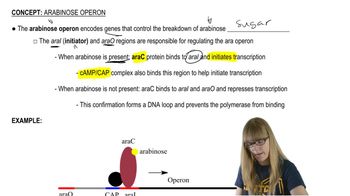Textbook Question
Answer these questions concerning promoters.
What is the common structure of a bacterial promoter with respect to consensus sequences?
399
views
 Sanders 3rd Edition
Sanders 3rd Edition Ch. 12 - Regulation of Gene Expression in Bacteria and Bacteriophage
Ch. 12 - Regulation of Gene Expression in Bacteria and Bacteriophage Problem 4
Problem 4 Verified step by step guidance
Verified step by step guidance



Identify similarities and differences between an inducible operon and a repressible operon in terms of
the presence and action of allosteric regulatory molecules.
The transcription of -galactosidase and permease is inducible in lac⁺ bacteria with a wild-type lac operon. Explain the mechanism by which lactose gains access to the cell to induce transcription of the genes.
Is attenuation the product of an allosteric effect? Is attenuation the result of a transcriptional or a translational activity? Explain your answers.
The trpL region contains four repeated DNA sequences that lead to the formation of stem-loop structures in mRNA. What are these stem-loop structures, and how do they affect transcription of the structural genes of the trp operon?